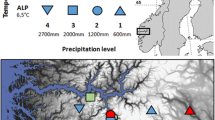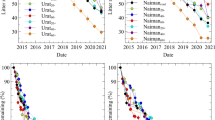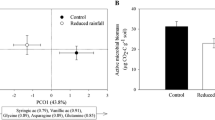Abstract
During litter decomposition, three major fates of litter carbon (C) are possible: emission as carbon dioxide (CO2) into the atmosphere, leaching of dissolved organic carbon (DOC), and translocation and transformation into soil organic carbon (SOC). Soil moisture, one of the key drivers of litter decomposition, is predicted to change in the future due to shifts in precipitation patterns. We explored the effects of low, medium and high rainfall intensities on the partitioning of litter carbon fates in a 6-month long laboratory experiment. We tracked carbon in 13C-labeled tulip poplar litter in a laboratory mesocosms by measuring respiration rates, dissolved organic carbon in the leachate, and soil organic carbon at the end of the experiment. Mesocosms with the same three rainfall intensities but without leaf litter were also set up. Leaching of labile carbon caused priming, but the effect was stronger in the low intensity treatment. Transport of litter-derived carbon also differed: in high intensity treatment there was more total carbon in the surface soil and more litter-derived carbon in in the deep soil layers. The cumulative CO2 efflux was not significantly different. Our results highlight that extreme rainfall events, as projected by most climate models, may lead to altered carbon cycling in temperate forest soils.







Similar content being viewed by others
References
Ayres E, Dromph KM, Bardgett RD (2006) Do plant species encourage soil biota that specialise in the rapid decomposition of their litter? Soil Biol Biochem 38:183–186. https://doi.org/10.1016/j.soilbio.2005.04.018
Balesdent J, Mariotti A, Guillet B (1987) Natural 13C abundance as a tracer for studies of soil organic matter dynamics. Soil Biol Biochem 19:25–30. https://doi.org/10.1016/0038-0717(87)90120-9
Bates D, Machler M, Bolker BM, Walker SC (2015) Fitting linear mixed-effects models using lme4. J Stat Softw 67:1–48
Beier C et al (2012) Precipitation manipulation experiments–challenges and recommendations for the future. Ecol Lett 15:899–911. https://doi.org/10.1111/j.1461-0248.2012.01793.x
Berg B (2000) Litter decomposition and organic matter trunover in northern forest soils. For Ecol Manag 133:13–22
Berg B, Lundmark JE (1987) Decomposition of needle litter in Pinus contorta and Pinus sylvestris monocultures-a comparison. Scand J For Res 2:3–12. https://doi.org/10.1080/02827588709382441
Bernal S, Butturini A, Sabater F (2002) Variability of DOC and nitrate responses to storms in a small Mediterranean forested catchment Hydrol Earth. Syst Sci 6:1031–1041. https://doi.org/10.5194/hess-6-1031-2002
Bernard MJ, Pitz SL, Chang CH, Szlavecz K (2015) Continuous C13 and N15 labeling of tree litter using a climate-controlled chamber. Commun Soil Sci Plant Anal 46:2721–2733. https://doi.org/10.1080/00103624.2015.1089273
Birch HF (1964) Mineralisation of plant nitrogen following alternate wet and dry conditions. Plant Soil 1:43–49
Bird JA, Kleber M, Torn MS (2008) C13 and N15 stabilization dynamics in soil organic matter fractions during needle and fine root decomposition. Org Geochem 39:465–477. https://doi.org/10.1016/j.orggeochem.2007.12.003
Blagodatskaya E, Kuzyakov Y (2008) Mechanisms of real and apparent priming effects and their dependence on soil microbial biomass and community structure: critical review. Biol Fertil Soils 45:115–131. https://doi.org/10.1007/s00374-008-0334-y
Bloor JMG, Bardgett RD (2012) Stability of above-ground and below-ground processes to extreme drought in model grassland ecosystems: Interactions with plant species diversity and soil nitrogen availability. PerspectPlant Ecol Evol Syst 14:193–204. https://doi.org/10.1016/j.ppees.2011.12.001
Borken W, Matzner E (2009) Reappraisal of drying and wetting effects on C and N mineralization and fluxes in soils. Glob Chang Biol 15:808–824. https://doi.org/10.1111/j.1365-2486.2008.01681.x
Borken W, Davidson EA, Savage K, Gaudinski J, Trumbore SE (2003) Drying and wetting effects on carbon dioxide release from organic horizons. Soil Sci Soc Am J 67:1888–1896. https://doi.org/10.2136/sssaj2003.1888
Brand WA, Coplen TB (2012) Stable isotope deltas: tiny, yet robust signatures in nature. Isot Environ Health Stud 48:393–409. https://doi.org/10.1080/10256016.2012.666977
Chao L et al (2019) Litter carbon and nutrient chemistry control the magnitude of soil priming effect. Funct Ecol 33:876–888. https://doi.org/10.1111/1365-2435.13278
Cisneros-Dozal LM, Trumbore SE, Hanson PJ (2007) Effect of moisture on leaf litter decomposition and its contribution to soil respiration in a temperate forest. J Geophys Res. https://doi.org/10.1029/2006jg000197
Cortez J (1998) Field decomposition of leaf litters: relationships between decomposition rates and soil moisture, soil temperature and earthworm activity. Soil Biol Biochem 30:783–793. https://doi.org/10.1016/s0038-0717(97)00163-6
Cotrufo MF et al (2014) Naphthalene addition to soil. surfaces: A feasible method to reduce soil micro-arthropods with negligible direct effects on soil C dynamics. Appl Soil Ecol 74:21–29. https://doi.org/10.1016/j.apsoil.2013.09.008
Cotrufo MF, Soong JL, Horton AJ, Campbell EE, Haddix Michelle L, Wall DH, Parton WJ (2015) Formation of soil organic matter via biochemical and physical pathways of litter mass loss. Nat Geosci 8:776–779. https://doi.org/10.1038/ngeo2520
Crow SE, Lajtha K, Bowden RD, Yano Y, Brant JB, Caldwell BA, Sulzman EW (2009) Increased coniferous needle inputs accelerate decomposition of soil carbon in an old-growth forest. For Ecol Manag 258:2224–2232. https://doi.org/10.1016/j.foreco.2009.01.014
Crumsey JM et al (2015) Exotic earthworm community composition interacts with soil texture to affect redistribution and retention of litter-derived C and N in northern temperate forest soils. Biogeochemistry 126:379–395. https://doi.org/10.1007/s10533-015-0164-6
Di Lonardo DP, Manrubia M, De Boer W, Zweers H, Veen GF, Van der Wal A (2018) Relationship between home-field advantage of litter decomposition and priming of soil organic matter. Soil Biol Biochem 126:49–56. https://doi.org/10.1016/j.soilbio.2018.07.025
Eimers MC, Buttle J, Watmough SA (2008) Influence of seasonal changes in runoff and extreme events on dissolved organic carbon trends in wetland- and upland-draining streams. Can J Fish Aquat Sci 65:796–808. https://doi.org/10.1139/f07-194
Eissfeller V, Beyer F, Valtanen K, Hertel D, Maraun M, Polle A, Scheu S (2013) Incorporation of plant carbon and microbial nitrogen into the rhizosphere food web of beech and ash. Soil Biol Biochem 62:76–81. https://doi.org/10.1016/j.soilbio.2013.03.002
Fahey TJ, Yavitt JB, Sherman RE, Groffman PM, Fisk MC, Maerz JC (2011) Transport of carbon and nitrogen between litter and soil organic matter in a northern hardwood forest. Ecosystems 14:326–340. https://doi.org/10.1007/s10021-011-9414-1
Fröberg M, Jardine PM, Hanson PJ, Swanston CW, Todd DE, Tarver JR, Garten CT (2007) Low dissolved organic carbon input from fresh litter to deep mineral soils. Soil Sci Soc Am J 71:347. https://doi.org/10.2136/sssaj2006.0188
Fröberg M, Hanson PJ, Trumbore SE, Swanston CW, Todd DE (2009) Flux of carbon from 14C-enriched leaf litter throughout a forest soil mesocosm. Geoderma 149:181–188. https://doi.org/10.1016/j.geoderma.2008.11.029
Hagedorn F, Kaiser K, Feyen H, Schleppi P (2000) Effects of redox conditions and flow processes on the mobility of dissolved organic carbon and nitrogen in a forest soil. J Environ Qual 29:288–297. https://doi.org/10.2134/jeq2000.00472425002900010036x
Hagedorn F, Bruderhofer N, Ferrari A, Niklaus PA (2015) Tracking litter-derived dissolved organic matter along a soil chronosequence using 14C imaging: biodegradation, physico-chemical retention or preferential flow? Soil Biol Biochem 88:333–343. https://doi.org/10.1016/j.soilbio.2015.06.014
Harper CW, Blair JM, Fay PA, Knapp AK, Carlisle JD (2005) Increased rainfall variability and reduced rainfall amount decreases soil CO2 flux in a grassland ecosystem. Glob Chang Biol 11:322–334. https://doi.org/10.1111/j.1365-2486.2005.00899.x
Hayhoe K et al (2006) Past and future changes in climate and hydrological indicators in the US Northeast. Clim Dyn 28:381–407. https://doi.org/10.1007/s00382-006-0187-8
Hentschel K, Borken W, Matzner E (2007) Leaching losses of inorganic N and DOC following repeated drying and wetting of a spruce forest soil. Plant Soil 300:21–34. https://doi.org/10.1007/s11104-007-9385-3
Hinton MJ, Schiff SL, English MC (1997) The significance of storms for the concentration and export of dissolved organic carbon from two Precambrian Shield catchments. Biogeochemistry 36:67–88. https://doi.org/10.1023/a:1005779711821
Hu ZH, Michaletz ST, Johnson DJ, McDowell NG, Huang ZQ, Zhou XH, Xu CG (2018) Traits drive global wood decomposition rates more than climate. Glob Chang Biol 24:5259–5269. https://doi.org/10.1111/gcb.14357
Huhta V, Setälä H (1990) Laboratory design to simulate complexity of forest floor for studying the role of fauna in the soil processes. Biol Fertil Soils 10:155–162
Jackson RB, Lajtha K, Crow SE, Hugelius G, Kramer MG, Pineiro G (2017) The ecology of soil carbon: pools, vulnerabilities, and biotic and abiotic controls. In: Futuyma DJ (ed) Annual review of ecology, evolution, and systematics, vol 48. Annual Reviews, Palo Alto, pp 419–445. https://doi.org/10.1146/annurev-ecolsys-112414-054234
Kaiser K, Guggenberger G (2000) The role of DOM sorption to mineral surfaces in the preservation of organic matter in soils. Org Geochem 31:711–725
Kaiser K, Guggenberger G (2005) Storm flow flushing in a structured soil changes the composition of dissolved organic matter leached into the subsoil. Geoderma 127:177–187. https://doi.org/10.1016/j.geoderma.2004.12.009
Kaiser K, Kalbitz K (2012) Cycling downwards–dissolved organic matter in soils. Soil Biol Biochem 52:29–32. https://doi.org/10.1016/j.soilbio.2012.04.002
Kammer A, Schmidt MWI, Hagedorn F (2011) Decomposition pathways of 13C-depleted leaf litter in forest soils of the Swiss Jura. Biogeochemistry 108:395–411. https://doi.org/10.1007/s10533-011-9607-x
Knapp AK et al (2002) Rainfall variability, carbon cycling, and plant species diversity in a mesic grassland. Science 298:2202–2205. https://doi.org/10.1126/science.1076347
Knapp AK et al (2008) Consequences of more extreme precipitation regimes for terrestrial ecosystems. Bioscience 58:811–821
Kuzyakov Y (2010) Priming effects: Interactions between living and dead organic matter. Soil Biol Biochem 42:1363–1371. https://doi.org/10.1016/j.soilbio.2010.04.003
Kuzyakov Y, Friedel JK, Stahr K (2000) Review of mechanisms and quantification of priming effects. Soil Biol Biochem 32:1485–1498. https://doi.org/10.1016/s0038-0717(00)00084-5
Lee X, Wu H-J, Sigler J, Oishi C, Siccama T (2004) Rapid and transient response of soil respiration to rain. Glob Chang Biol 10:1017–1026. https://doi.org/10.1111/j.1365-2486.2004.00787.x
Lehmann J, Kleber M (2015) The contentious nature of soil organic matter. Nature 528:60–68. https://doi.org/10.1038/nature16069
Lensing JR, Wise DH (2007) Impact of changes in rainfall amounts predicted by climate-change models on decomposition in a deciduous forest. Appl Soil Ecol 35:523–534. https://doi.org/10.1016/j.apsoil.2006.09.015
Ma YN, Filley TR, Johnston CT, Crow SE, Szlavecz K, McCormick MK (2013) The combined controls of land use legacy and earthworm activity on soil organic matter chemistry and particle association during afforestation. Org Geochem 58:56–68. https://doi.org/10.1016/j.orggeochem.2013.02.010
Ma YN, Filley TR, Szlavecz K, McCormick MK (2014) Controls on wood and leaf litter incorporation into soil fractions in forests at different successional stages. Soil Biol Biochem 69:212–222. https://doi.org/10.1016/j.soilbio.2013.10.043
Ma YN, McCormick MK, Szlavecz K, Filley TR (2019) Controls on soil organic carbon stability and temperature sensitivity with increased aboveground litter input in deciduous forests of different forest ages. Soil Biol Biochem 134:90–99. https://doi.org/10.1016/j.soilbio.2019.03.020
McDowell WH, Wood T (1984) Podzolization: soil processes control dissolved organic carbon concentrations in stream water. Soil Sci 137:23–32. https://doi.org/10.1097/00010694-198401000-00004
Michalzik B, Kalbitz K, Park JH, Solinger S, Matzner E (2001) Fluses and concentrations of dissolved organic carbon and nitrogen—a synthesis for temperate forests. Biogeochemistry 52:173–205
Mikutta R, Mikutta C, Kalbitz K, Scheel T, Kaiser K, Jahn R (2007) Biodegradation of forest floor organic matter bound to minerals via different binding mechanisms. Geochim Cosmochim Acta 71:2569–2590. https://doi.org/10.1016/j.gca.2007.03.002
NEON (2019) National Ecological Observatory Network. 2019. Data Products: NEON.DP1.00096.01, Battelle, Boulder, CO, USA. Provisional data downloaded from https://data.neonscience.org Accessed 5 Aug 2019
Ngao J, Epron D, Brechet C, Granier A (2005) Estimating the contribution of leaf litter decomposition to soil CO2 efflux in a beech forest using C-13-depleted litter. Glob Chang Biol 11:1768–1776. https://doi.org/10.1111/j.1365-2486.2004.01014.x
NRCS (2015) Soil Survey Staff, Natural Resources Conservation Service, United States Department of Agriculture. Web Soil Survey. https://websoilsurvey.nrcs.usda.gov/ Accessed 19 Nov 2015
Paul BK, Lubbers IM, van Groenigen JW (2012) Residue incorporation depth is a controlling factor of earthworm-induced nitrous oxide emissions. Glob Chang Biol 18:1141–1151. https://doi.org/10.1111/j.1365-2486.2011.02525.x
Pitz SL, Megonigal JP, Chang C-H, Szlavecz K (2018) Methane fluxes from tree stems and soils along a habitat gradient. Biogeochemistry 137:307–320. https://doi.org/10.1007/s10533-017-0400-3
Prescott CE (2010) Litter decomposition: what controls it and how can we alter it to sequester more carbon in forest soils? Biogeochemistry 101:133–149. https://doi.org/10.1007/s10533-010-9439-0
Rubino M et al (2010) Carbon input belowground is the major C flux contributing to leaf litter mass loss: evidences from a 13C labelled-leaf litter experiment. Soil Biol Biochem 42:1009–1016. https://doi.org/10.1016/j.soilbio.2010.02.018
Schmidt MW et al (2011) Persistence of soil organic matter as an ecosystem property. Nature 478:49–56. https://doi.org/10.1038/nature10386
Schuster MJ (2016) Increased rainfall variability and N addition accelerate litter decomposition in a restored prairie. Oecologia 180:645–655. https://doi.org/10.1007/s00442-015-3396-1
Setälä H, Martikainen E, Tyynismaa M, Huhta V (1990) Effects of soil fauna on leaching of nitrogen and phosphorus from experimental systems simulating coniferous forest floor. Biol Fertil Soils 10:170–177
Soong JL, Parton WJ, Calderon F, Campbell EE, Cotrufo MF (2015) A new conceptual model on the fate and controls of fresh and pyrolized plant litter decomposition. Biogeochemistry 124:27–44. https://doi.org/10.1007/s10533-015-0079-2
Soong JL et al (2016) Soil microarthropods support ecosystem productivity and soil C accrual: evidence from a litter decomposition study in the tallgrass prairie. Soil Biol Biochem 92:230–238. https://doi.org/10.1016/j.soilbio.2015.10.014
Sulzman EW, Brant JB, Bowden RD, Lajtha K (2005) Contribution of aboveground litter, belowground litter, and rhizosphere respiration to total soil CO2 efflux in an old growth coniferous forest. Biogeochemistry 73:231–256. https://doi.org/10.1007/s10533-004-7314-6
Szlavecz K et al (2018) Litter quality, dispersal and invasion drive earthworm community dynamics and forest soil development. Oecologia. https://doi.org/10.1007/s00442-018-4205-4
Trenberth KE (2011) Changes in precipitation with climate change. Clim Res 47:123–138. https://doi.org/10.3354/cr00953
Walter J et al (2013) Combined effects of multifactor climate change and land-use on decomposition in temperate grassland. Soil Biol Biochem 60:10–18. https://doi.org/10.1016/j.soilbio.2013.01.018
Wu Z, Dijkstra P, Koch GW, PeÑUelas J, Hungate BA (2011) Responses of terrestrial ecosystems to temperature and precipitation change: a meta-analysis of experimental manipulation. Glob Chang Biol 17:927–942. https://doi.org/10.1111/j.1365-2486.2010.02302.x
Yesilonis I, Szlavecz K, Pouyat R, Whigham D, Xia L (2016) Historical land use and stand age effects on forest soil properties in the Mid-Atlantic US. For Ecol Manag 370:83–92. https://doi.org/10.1016/j.foreco.2016.03.046
Zhang WD, Wang SL (2012) Effects of NH4+ and NO3- on litter and soil organic carbon decomposition in a Chinese fir plantation forest in South China. Soil Biol Biochem 47:116–122. https://doi.org/10.1016/j.soilbio.2011.12.004
Zieger SL, Eissfeller V, Maraun M, Scheu S (2015) Incorporation of carbon and nitrogen from leaf litter differing in structural compounds into soil microarthropods of a deciduous forest. Pedobiologia 58:219–227. https://doi.org/10.1016/j.pedobi.2015.10.001
Acknowledgements
This study was supported by NSF-ACI 1244820, a seed grant from the Energy, Environment, Sustainability and Health Institute at Johns Hopkins University, and the EPS Robert Balk Fellowship Fund. We appreciate help from Kaley Sten, Jess Carney, Xinting Yu, and Jia-Hsing Wu during the experiment. Helpful and constructive comments by two anonymous reviewers on earlier versions of the manuscript substantially improved the text. Some soil data are NEON data products. The National Ecological Observatory Network is a program sponsored by the National Science Foundation and operated under cooperative agreement by Battelle Memorial Institute. This material is based in part upon work supported by the National Science Foundation through the NEON Program.
Author information
Authors and Affiliations
Corresponding author
Additional information
Responsible Editor: Melany Fisk.
Publisher's Note
Springer Nature remains neutral with regard to jurisdictional claims in published maps and institutional affiliations.
Electronic supplementary material
Below is the link to the electronic supplementary material.
Rights and permissions
About this article
Cite this article
Yang, X., Szlavecz, K., Pitz, S.L. et al. The partitioning of litter carbon fates during decomposition under different rainfall patterns: a laboratory study. Biogeochemistry 148, 153–168 (2020). https://doi.org/10.1007/s10533-020-00651-0
Received:
Accepted:
Published:
Issue Date:
DOI: https://doi.org/10.1007/s10533-020-00651-0




